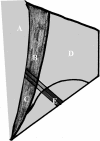Laparoscopic transabdominal preperitoneal repair of spigelian hernia
- PMID: 16882419
- PMCID: PMC3016144
Laparoscopic transabdominal preperitoneal repair of spigelian hernia
Abstract
Background: A Spigelian hernia is a congenital defect in the transversus aponeurosis fascia. Traditionally, an anterior hernioplasty was used to repair these defects. This study aimed to document our experience with laparoscopic transabdominal preperitoneal repair for Spigelian hernia.
Methods: Eight patients underwent laparoscopic transabdominal Spigelian hernia repair. All patients underwent creation of a peritoneal flap, sac dissection, identification and approximation of the fascial defect, mesh reinforcement, and reperitonealization.
Results: All patients presented with pain. An intermittent palpable mass was noticed in 4 patients. One third of the patients had undergone prior surgery and none had an incisional hernia. Only 1 patient presented with severe pain for 1 day; however, there was no bowel strangulation intraoperatively. All patients underwent laparoscopic transabdominal preperitoneal repair. No postoperative complications occurred. There have been no recurrences at a mean follow-up of 41 months (range, 8 to 96).
Conclusion: Laparoscopic transabdominal preperitoneal repair of Spigelian hernia is safe, easy, and feasible for experienced laparoscopic surgeons.
Figures













References
-
- Spangen L. Spigelian hernia. Surg Clin North Am. 1984; 64: 351– 366 - PubMed
-
- Kalaba Z. Spigelian hernia: a case of typical Spigelian hernia in an elderly man. Ugeskr Laeger. 1999; 161: 2095– 2096 - PubMed
-
- Spangen L. Spigelian hernia. World J Surg. 1989; 13: 573– 580 - PubMed
-
- Palanivelu C. Laparoscopic management of rare hernia. In: Operative Manual of Laparoscopic Hernia Surgery. India: Gem Foundation; 2004; 295: 305
-
- Larson DW, Farley DR. Spigelian hernias: repair and outcome for 81 patients. World J Surg. 2002; 26 ( 10): 1277– 1281 - PubMed
MeSH terms
LinkOut - more resources
Full Text Sources
